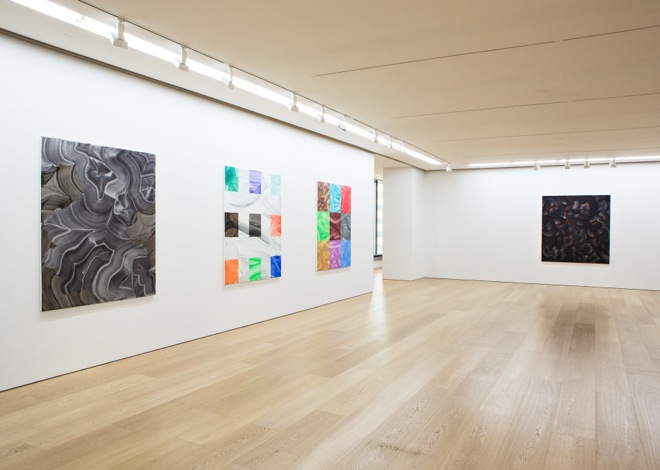“On the Side Where There is No Handrail”: Bernard Frize solo exhibition
Galerie Perrotin Hong Kong (17/F, 50 Connaught Road, Central, Hong Kong) Aug 29–Sep 28, 2013
In his recent exhibition at Galerie Perrotin in Hong Kong, Bernard Frize uses mostly acrylic and resin to give eight new paintings a plasticized feel. The choice of medium is most effective when the artist allows the raw materiality of his brushwork to forge the painting’s basic design. This is especially true for the two best works on display here — “Nelio” and “Gliale” — these are the two paintings in which Frize seems to let himself go, while the others appear as though they are striving to be pleasant — perhaps “Nelio” and “Gliale” still strive in the same direction, though they manage to pull it off.
“Gliale” consists of nine colored boxes arranged in stacks of three. Thick brushstrokes move from one colored square to the next without any awkwardness or breaking. “Nelio” has a similar motif, only against a background of gray-white swaths, and its nine squares are much smaller – the contained elements of the painting, rather than the containers, as in “Gliale.”

伯纳德·弗莱兹, 《在没有栏杆的一边》, 展览现场

伯纳德·弗莱兹, 《Gliale》 布面丙烯树脂, 160 x 140 cm, 2013

伯纳德·弗莱兹, 《Nelio》, 布面丙烯树脂, 160 x 140 cm, 2013
Color is, of course, the most noticeable feature of this kind of work. The key to a successful abstract painting, however, is rhythm. It is in these two paintings that Frize proves himself as a rhythmicist, unconstrained by the dictates of pattern; rather, impulse is allowed free rein—as it should be.
In fact, the problem for Frize is that so often this is restrained. The pseudo-psychedelic designs (folded diamond-shaped swirls) in paintings like “Semploi” and “Seplia” are hardly unique, and whenever cliché begins to emerge where such bright and lively palette is employed, the risk becomes decorativeness—wallpaper. (In fact, the carpeting in the hotel room in which I’m writing this isn’t too far off from Frize’s latest efforts. And the colors in “Semploi,” reminiscent of toothpaste, don’t help quell the drab domestic comparisons, either.) At his most stagnant, there is a rigidity of design in Frize that is bothersome. It often seems as though he is striving to imbue a light “conceptual” touch to what essentially winds up looking like collectors’ art.
Of course, it is difficult to try to do something with “pure painting” in 2013, as Frize is ambitiously attempting. The desire to go outside of language has become a doctrine in itself, and nothing that impressive or new has arguably been accomplished through pure color and form since the Color Fieldists had their day. Honestly, Frize is at his most effective in the sole oil painting included in the show, “Polji.” The effect is not all that different from the sticky-bright effect of the resinated acrylics—the tension between the colored swirls, achieved through an accentuating fading white line between each—has the effect of creating a peculiar harmony among the colors. It must be said, though, that these are based on mostly complementary schemes. Perhaps, then, there is an experiment at stake here to see how far the artist can extend his flirtation with academic abstraction while still retaining something of his own. But that’s a stretch, as, in the end, there is too little tension in these canvases to excavate any great internal dialectic.

伯纳德·弗莱兹, 《Semploi》, 布面丙烯树脂, 170.5 x 170.5 cm, 2013

伯纳德·弗莱兹, 《Seplia》, 布面丙烯树脂, 170.5 x 170.5 cm, 2013